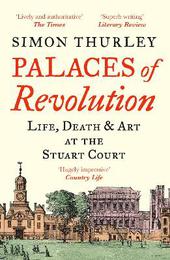
|
Palaces of Revolution: Life, Death and Art at the Stuart Court
Paperback / softback
Main Details
| Title |
Palaces of Revolution: Life, Death and Art at the Stuart Court
|
| Authors and Contributors |
By (author) Simon Thurley
|
| Physical Properties |
| Format:Paperback / softback | | Pages:560 | | Dimensions(mm): Height 198,Width 129 |
|
| Category/Genre | Residential buildings and domestic buildings
British and Irish History
Military history |
|---|
| ISBN/Barcode |
9780008389994
|
| Classifications | Dewey:941.060922 |
|---|
| Audience | |
|---|
|
Publishing Details |
| Publisher |
HarperCollins Publishers
|
| Imprint |
William Collins
|
| Publication Date |
26 May 2022 |
| Publication Country |
United Kingdom
|
Description
The story of the Stuart dynasty is a breathless soap opera played out in just a hundred years in an array of buildings that span Europe from Scotland, via Denmark, Holland and Spain to England. Life in the court of the House of Stuart has been shrouded in mystery: the first half of the century overshadowed by the fall and execution of Charles I, the second half in the complete collapse of the House itself. Lost to time is the extraordinary contribution the Stuarts made to the fabric of sovereignty. Every palace they built, painting they commissioned, or artwork they acquired was a direct reflection of the lives that they led and the way that they thought. Palaces of Revolution explores this rich history in graphic detail, giving a unique insight into the lives of this famous dynasty. It takes us from Royston and Newmarket, where James I appropriated most of the town centre as a sort of rough-and-ready royal housing estate, to the steamy Turkish baths at Whitehall where Charles II seduced his mistresses. We see the intimate private lives of the monarchs, presented through the buildings in which they lived and the objects they commissioned, creating an entirely new narrative of the Stuart century. Palaces of Revolution traces this extraordinary period across the places and palaces on which the action played out, giving us a thrilling new history of this remarkable dynasty.
Author Biography
Dr Simon Thurley is one of the UK's leading architectural historians. He is Chief Executive of English Heritage - the government's principle advisor on the historic environment.
Reviews'Simon Thurley may be congratulated on a splendid achievement, which serves several different branches of history at once, as well as those who appreciate a clear and lively literary style ... An important addition to knowledge' Ronald Hutton, Times Literary Supplement 'A hugely impressive, readable book that covers its broad canvas with assurance ... Thoughtfully illustrated and furnished with plans of the buildings, itself a huge accomplishment.' John Goodall, Country Life 'In his admirably readable new book, Simon Thurley, who probably knows more about the palaces of the 16th and 17th centuries than anyone alive, has written a chronological survey of the royal residences of the Stuarts, a period of just over 100 years. You almost can read it as an alternative history of the dynasty ... Lively and authoritative' Andrew Taylor, The Times 'Palaces of Revolution is far more than just a history book ... The author's knowledge ... is unprecedented, elevating the historical survey into an alternative reading of the Stuart Dynasty ... one only has to read this book to hear the walls talking. From secret seductions to fierce fighting, Thurley writes with great detail, invigorating the historical narratives we know and presenting new stories' The Scottish Field 'There can be few as well-placed to write about the buildings associated with the Stuart monarchy as Simon Thurley ... This book - engagingly written and beautifully illustrated - is a comprehensive account of those achievements, and of the role that buildings played in the political life of early modern Britain.' Historic House magazine 'The culmination of nearly 30 years of research, [Palaces of Revolution] takes us back in time to bring these "hollow citadels of ceremony" and those who occupied them to life once again.' Apollo
|